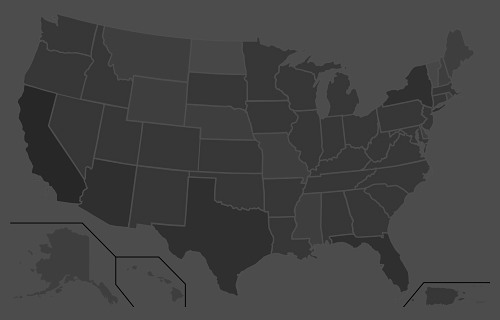“Our added winter moisture and active calling period led to a very long nesting and hatching season, starting in late April and extending into early summer, with chicks hatching as late as early July,” O’Dell said. “From a population standpoint, we are out of a deficit for the first time since 2001-2002. Quail are starting to pop up in places they haven’t been seen in a while.
“If you’ve never had the chance to experience what Arizona quail hunting built its name on, then this would be the year to get out and enjoy it.”
Meanwhile, hunters should note that the season for Mearns’ quail doesn’t begin until Dec. 4. It’s summer rainfall that plays a key role in nesting success and population numbers of this species. After a spotty and relatively weak monsoon across southern Arizona, these birds are likely to be abundant only in pockets that received sufficient precipitation this summer.
A valid Arizona hunting or combination hunt and fish license is required for all hunters 10 and older. Those hunters under 10 must either have a valid hunting or combination hunt and fish license, or be accompanied by an adult who possesses a valid hunting or combination hunt and fish license. Licenses can be purchased online or at license dealers statewide. A youth combination hunt and fish license (ages 10 to 17) is $5.
The general bag limit is 15 quail per day in the aggregate, of which no more than eight may be Mearns’ quail (when the Mearns’ season opens Dec. 4). The general possession limit is 45 quail in the aggregate after opening day, of which no more than 15 Gambel’s, scaled or California quail in the aggregate may be taken in any one day. After the opening of the Mearns’ season, the 45-quail possession limit may include 24 Mearns’ quail, of which no more than eight may be taken in any one day.
More quail-hunting information can be found on the department’s website at https://www.azgfd.com/Hunting/. Another resource for both new and experienced hunters alike is “An Introduction to Hunting Arizona’s Small Game.” Written by Randall D. Babb, the 196-page, full-color book covers where and how to hunt small game birds (like quail), squirrels, rabbits, ducks and geese. It also includes how to prepare and cook your harvest, with illustrations and recipes. The book can be ordered for $16.95 at www.azgfd.gov/publications.
Finally, hunters should check out O’Dell’s techniques for field-dressing quail at https://www.youtube.com/watch?v=3gRwZAcWzzk.
####
Publishers Notes: OUT OF STATE HUNTERS, FISHERMEN & OUTDOOR ENTHUSIASTS; Due to the Covid 19 pandemic, there could be limitations for OUT of STATE hunters, fishermen and other outdoor enthusiasts to include a 14-day quarantine requirement or negative COVID-19 testing alternative. Please check with the State's Department of Natural Resources BEFORE you travel or apply for the 2020 Fall Hunts.
Disclaimer: The views expressed on this site are that of the authors and not necessarily that of TBC Press
Colorado Seasonal Closures in place at State Wildlife Areas around Gunnison Basin
Submitted by: TBC Press
Posted on: 12/14/21
The Backcountry Press
The country's premier daily HUNTING, FISHING & OUTDOOR news in the USA and around the globe. Read whats happening in your neck of the woods & beyond.
© 2020 TBC Press - All Rights Reserved Website Design by:
News # 14668
In an effort to protect critical winter ranges for deer, elk, Gunnison sage-grouse and other wildlife, multiple Colorado State Wildlife Areas have seasonal closures in place in the Gunnison Basin.
Closures went into effect Dec. 1 for the Almont Triangle, Centennial and Gunnison SWAs.
Seasonal closures are imperative for sustaining healthy wildlife populations. As the human footprint continues to grow through the impacts of development and increased recreation, there are fewer areas for wildlife to seek refuge during the harsh winter months when forage is less abundant and lacking in nutritional value.
“Even mild winters take a toll on wildlife, so these closures are in place to protect wildlife and to help get them through,” said Brandon Diamond, area wildlife manager for CPW. “We all value wildlife in the Gunnison Basin, and it’s up to all of us to protect these animals. There are plenty of other areas in the basin for people to recreate during the winter. Please, respect our closures.”
Big-game animals come down from the high country as temperatures turn colder, snow piles up and they seek easier living conditions. Human activity in these areas during the winter months could cause animals to unnecessarily expend calories, hurting their chances of survival and producing healthy offspring in the spring season.
Each year, CPW issues citations and fines to people in violation of the seasonal closures. Access points are clearly signed and gated to indicate closures.
The closure at Almont Triangle and Gunnison SWAs runs from Dec. 1 through April 30. The closure at Centennial SWA is in place from Dec. 1 through June 30.
Here is a list of the other state wildlife area closures in the basin:
- Miller Ranch State Wildlife Area, located northwest of Gunnison: closed March 1 through June 30. Exception for youth hunts; call the Gunnison wildlife office for information at 970-641-7060.
- Sapinero State Wildlife Area, located west of Gunnison: snowmobiles allowed only on the main roads – Rainbow Lake and Red Creek roads – through the wildlife area.
- Tomichi Creek State Wildlife Area, located south of Gunnison: open to fishing year around, closed to all public access other than fishing from the end of waterfowl season through June 30.
On all public lands in the Gunnison Basin, collection of shed antlers is prohibited from Jan. 1 through April 30. Additionally, it is illegal to possess antlers or horns on public lands in Game Management Units 54, 55, 551, 66, 67 between legal sunset and 10 a.m. from May 1 through May 15.
For more information about closures, contact the Gunnison wildlife office; or for more information on other closures or restrictions on federal lands, please check with the Gunnison office of the U.S. Forest Service at 970-641-0471 or the Bureau of Land Management at 970-642-4940.
View the Colorado State Recreation Lands brochure online at https://cpw.state.co.us/Documents/RulesRegs/Brochure/lands.pdf
####












